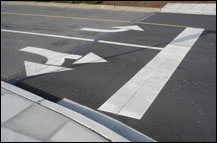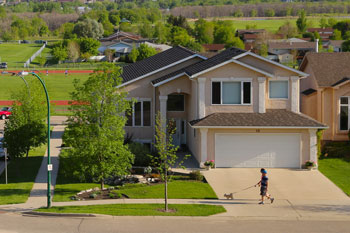Markings on the pavement are a major element in any system of traffic control. Pavement markings serve a variety of functions, including;
- Lane definition
- Separation of opposing flows
- Passing control
- Lane usage and designation
- Pedestrian crosswalks
- Stop lines
- Parking areas
- Word messages
The motoring public depends heavily upon pavement markings for guidance, vehicle positioning and information. Unless pavement markings are clear, consistent and uniform in their application, drivers may become confused and uncertain of their purpose.
Pavement markings are often used to supplement the regulations or warnings of other traffic control devices, such as traffic signs or signals. Sometimes they are used alone to convey regulations or warnings which would not be obtainable by other traffic control devices.
Under favorable conditions, pavement markings convey information to the driver without diverting the driver’s attention from the road. They however have limitations when:
- They may be entirely obliterated by snow;
- They may not be clearly visible when wet; and
- They have limited durability.
Classifications
There are three basic configurations of pavement markings which include longitudinal markings, transverse markings, and symbols / word markings.
- Longitudinal Markings delineate travelled lanes and may provide:
- directional dividing lines which separate traffic flows in opposing direction;
- lane lines which separate traffic flows in the same direction;
- edge lines which mark the right edge of the right travelled lane or the left edge of the left travelled lane;
- continuity lines which are used across the entire length of merging or diverging areas of acceleration, deceleration, or auxiliary lanes;
- guiding lines which are extensions of edge lines or lane lines through intersections; or
- other lines which mark special operational characteristics of reversible lanes, two-way left-turn lanes, reversed lanes, and bus bays.
- Transverse Markings are installed across the pavement in the following situations:
- crosswalk lines which mark the location of pedestrian crosswalks;
- stop lines which indicate where vehicles stop at intersections or railway crossings;
- areas which indicate where traffic flows diverge or converge;
- diagonal lines which mark pavement areas which are not part of a travelled lane; or
- lines which mark parking spaces.
- Symbols and Words may be used on the pavement to supplement standard signs, or by themselves, for the purpose of regulating, warning or guiding traffic. These markings include:
- arrows which indicate vehicle movements permitted in a lane;
- diamonds which indicate that a lane is reserved in accordance with appropriate signing which explains the restrictions;
- "X" symbols which indicate the approach to a railway crossing;
- other symbols;
- word and number messages.
Principles of Markings
Longitudinal Marking Principles
The main purposes of longitudinal pavement markings are discussed in the following section.
- Longitudinal pavement markings, when used as dividing lines between traffic lanes, conform to the following basic principles:
- Yellow lines delineate the separation of traffic flows in opposing directions while White lines delineate the separation of traffic flows in the same direction.
- Broken lines indicate permissive traffic regulations. Broken Yellow lines indicate that adequate sight distances are available, and passing is permitted. Broken White lines indicate that lane changing is permitted.
- Solid lines indicate restrictive traffic regulations. Solid Yellow lines indicate that adequate passing sight distance is not available and that passing, therefore, is not permitted. Solid White lines indicate that lane changing is unsafe and is not permitted.
- Longitudinal pavement markings, when used as dividing lines between traffic lanes and shoulders conform to the following basic principles
- Solid Yellow edge lines delineate the separation of traffic lanes and shoulders when the shoulder is to the left of the traffic lane in the direction of travel.
- Solid White edge lines delineate the separation of traffic lanes and shoulders when the shoulder is to the right of the traffic lane in the direction of travel.
- A wide line is used for emphasis in those areas where standard markings require reinforcement.

Transverse Marking Principles
Transverse markings are White, except for markings and diagonal lines in medians which are Yellow.
Because of the low approach angle at which pavement markings are viewed, it is necessary that transverse lines be proportioned to give visibility equal to that of longitudinal lines.
Symbols and Word Principles
The following principles apply to symbols and words:

- all symbols and words are White.
- the use of symbols is preferred to words.
- where used, word messages should be as brief as possible.
- because of the low angle at which such markings are viewed, they must be elongated in the direction of traffic movement to provide adequate legibility.
Standardization of Markings
Well chosen and well designed pavement markings provide guidance to drivers. Standardization and consistency are essential to provide safe operating conditions. As with all traffic control devices, markings must be uniform so they may be easily recognized and understood.
Installation
The Traffic Section is responsible for the engineering aspects of pavement markings, which includes type, size and location of markings. Our office works closely with the Streets and Roads Section of the Operations Division who is responsible for the installation and ongoing maintenance of the pavement markings.
The City of Brandon adheres to guidelines outlined in the Manual of Uniform Traffic Control Devices for Canada (MUTCDC) established by the Transportation Association of Canada (TAC). This manual provides guidelines for the installation of pavement markings along with the principles of markings.
Pavement markings are generally painted twice a year (spring & fall) on the major streets within the City of Brandon. Lower traffic volume streets generally only require one application per year to ensure good year-round visibility of pavement markings.
Newly constructed and resurfaced streets are marked as soon as possible after paving is complete, however there may be some delays due to weather or ongoing construction activities. Care and caution should be taken in unmarked areas until pavement markings are completed.
When approaching the line painting operation, please be patient and wait until the truck finishes painting the section of street on which it is travelling. Streets are painted during the evening hours to help reduce conflicts with the motoring public, however not all conflicts with motorists may be avoided when painting pavement markings. In such instances, please wait until the next major intersection for an opportunity to pass the paint truck. Passing too closely risks damage to vehicles and marking the road. A common sight on freshly painted roads is “tracking” which is caused by impatient motorists passing the paint truck and tracking fresh paint across the centerline into the travel portion.
Reporting Pavement Markings
Should you observe pavement markings that do not convey information to the driver as a result of not being clearly visible or being faded, please contact the Streets and Roads section of the Operations Division.
Public Works / Streets and Roads
900 Richmond Avenue East
Brandon, Manitoba R7A 7M1
Phone: 204-729-2285
Office Hours: 8:00 a.m. – 4:30 p.m. (Mon. – Fri.)
Should you wish to request the installation of new pavement markings as a result of safety concerns, or would like a street reviewed for additional pavement markings, please contact the Traffic Section of the Engineering Department.
Engineering Department / Traffic Section
City Hall, 410 – 9th Street
Brandon, Manitoba R7A 6A2
Phone: 204-729-2214
Fax: 204-725-23235
Email:engineering@brandon.ca
Office Hours: 8:30 a.m. - 5:00 p.m. (Mon.-Fri.)







